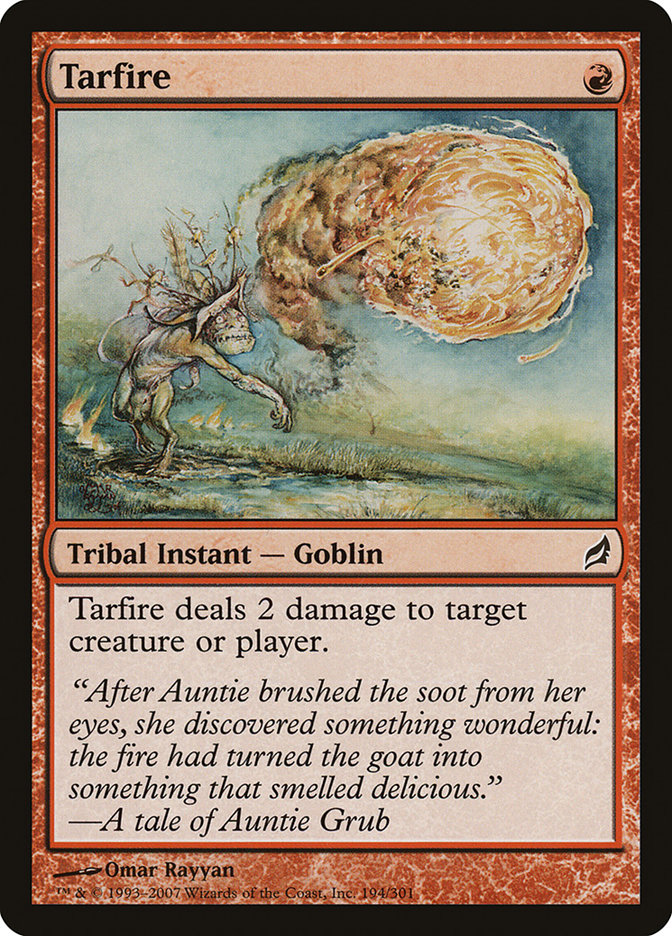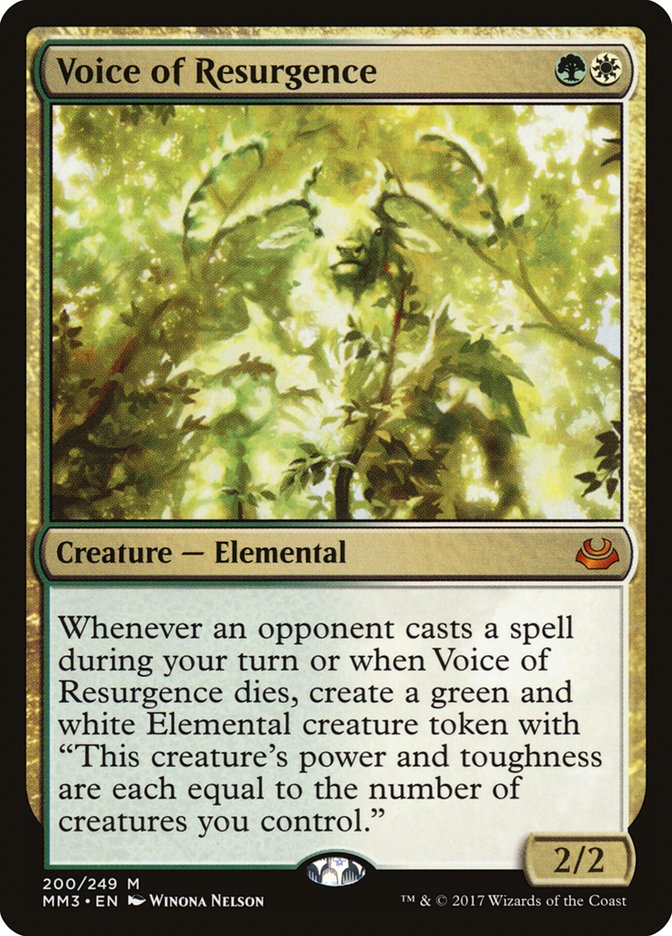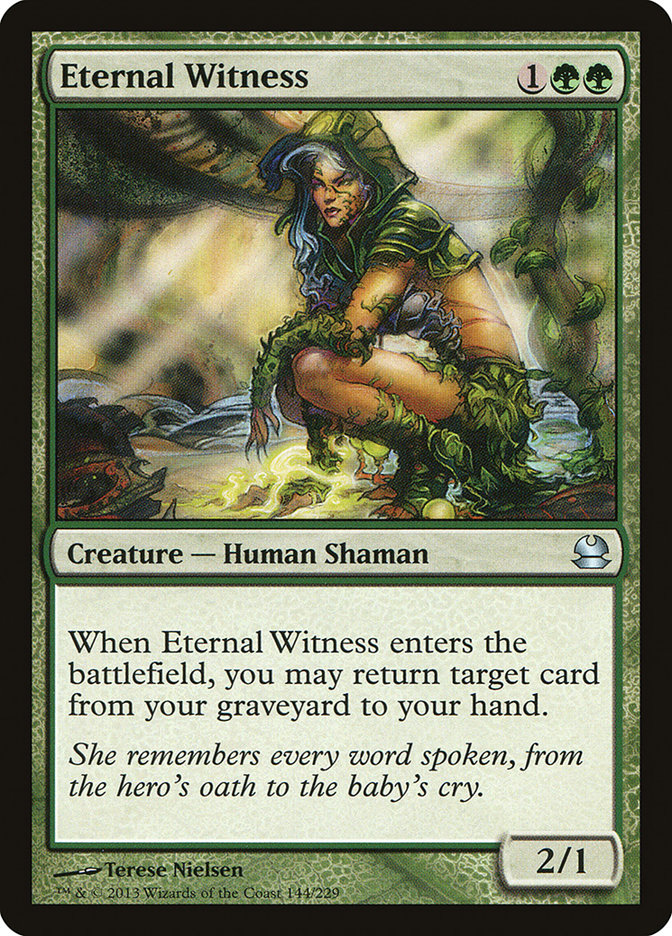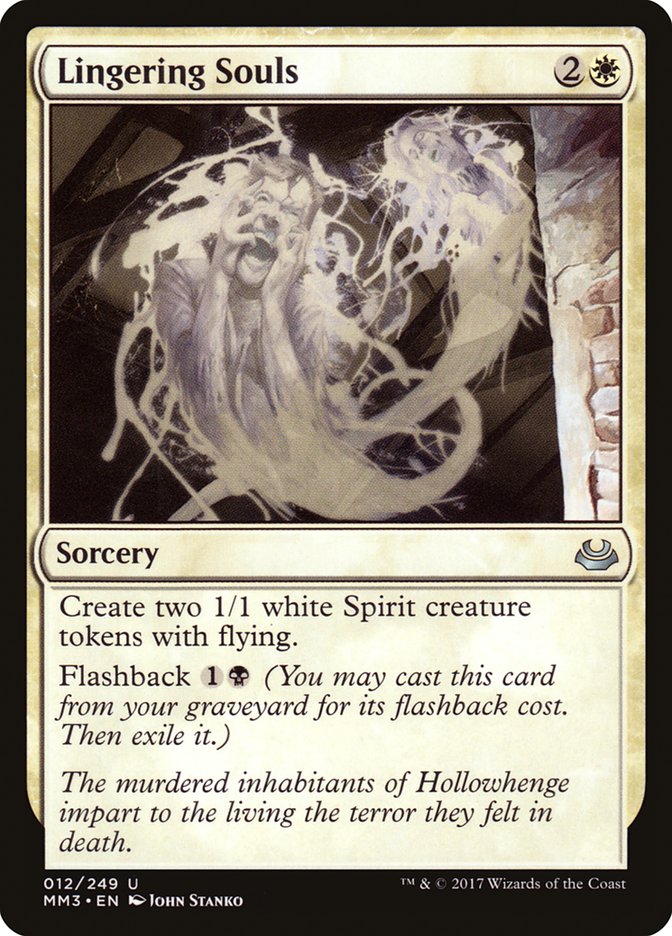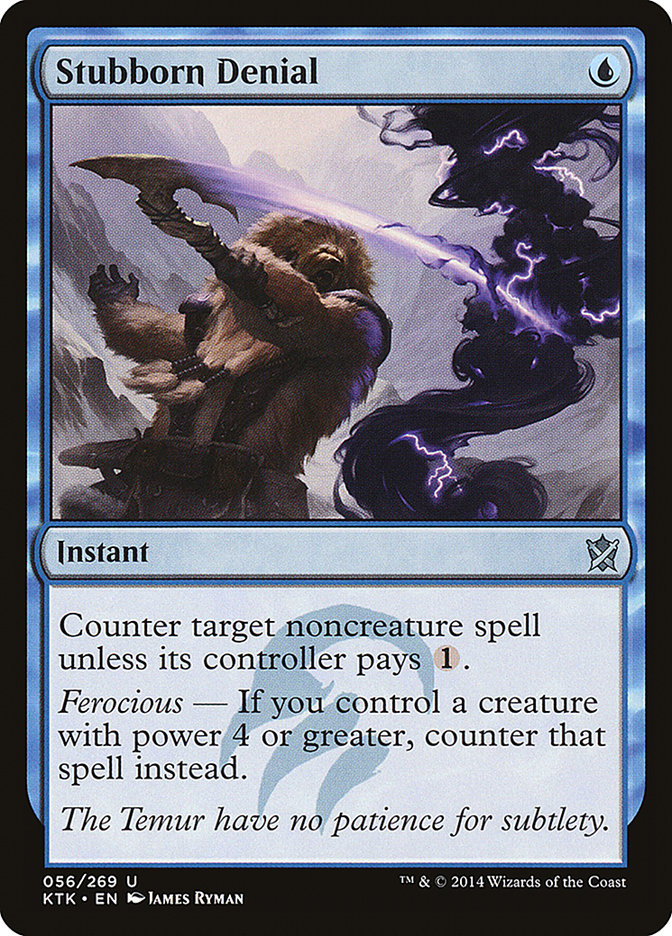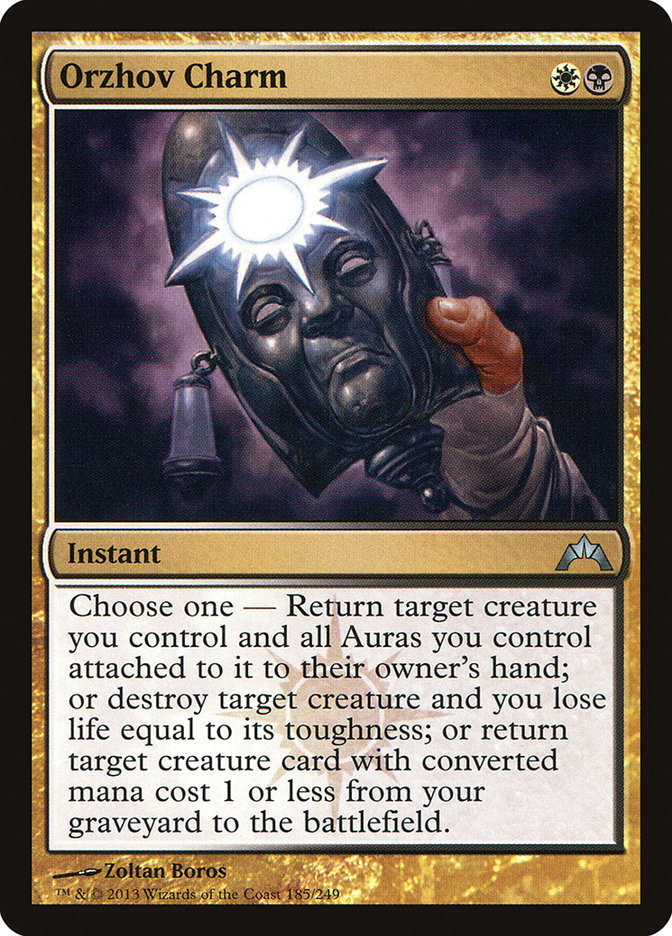I’ve always wondered what it would take for me to branch out a bit in Modern. For the most part, I try to play decks that fit my play style. That’s one of the biggest reasons I’ve been so locked in on Temur variations since well before Splinter Twin got sent to the great beyond. I just like playing a tempo game, and Temur allows me to do that with a lot of the tools at its disposal. But Modern is a harsh teacher, and the lessons we learn are usually at the expense of the matches we lose.
“Turn 3. How about that tempo, buddy?”
Fair decks in Modern are often limited by the colors you choose to play. If you aren’t playing black for Fatal Push or white for Path to Exile, you are likely going to have trouble killing big threats like Tarmogoyf. Lightning Bolt and other burn-based removal can only go so far in keeping creatures off the battlefield, but their limitations are offset by the ability to go to the dome. That’s why Lightning Bolt has been the premier removal spell in Modern since the format’s debut. But as the format grows older, more and more creatures see print that aren’t vulnerable to Lightning Bolt.
Fatal Push was a big addition to Modern because it opened up a lot of space for decks that couldn’t normally compete with the strength of Lightning Bolt and it didn’t have the gigantic downside of Path to Exile. Fatal Push changed the game, and you’re only going to see it grow in popularity as a way to interact with creatures. That will mean one (or more) of three things is going to happen in order to compensate for the existence of such a potent removal spell:
1) People will lower their curve and play a few more cheap creatures.
Fatal Push gives the fair decks a very cheap way to interact with early creatures. If your deck relies on casting one or two creatures in the early turns to apply pressure, don’t expect them to last too long. To beat decks that play Fatal Push, I expect more creatures that explode onto the battlefield. That means more stuff like Burning-Tree Emissary and Hidden Herbalists at the two-drop slot along with a slew of one-mana creatures to overload those cheap removal spells.
2) People will try their best to not play creatures at all.
Combo decks can usually get away with playing zero creatures. When the cards being printed and seeing play push toward being interactive, the safest route is to do the opposite. That’s one of the main reasons we saw Ad Nauseam win the most recent Modern Open. Well, that and the fact that all that interaction tends to slow the format down a bit. Ad Nauseam isn’t a particularly fast combo deck, after all.
3) Two- to four-mana creatures will fall out of favor.
I don’t remember the last time I saw a Dark Confidant serve up a card. For a while, before the most recent Modern bannings, decks like Infect were everywhere. That meant Dark Confidant would go untouched in many of the games you cast it. As of now, there is so much removal and discard running around that the likelihood of such a creature surviving a turn cycle is very low. Hell, it even dies to Tarfire.
This is one of the biggest reasons that Jund Death’s Shadow has gained in popularity over the old-school version of Jund featuring Dark Confidant. Overall, your creatures are cheaper, which means it doesn’t hurt as badly to have them hit by a removal spell. Well, that and the fact that neither Tarmogoyf nor Death’s Shadow usually dies to Lightning Bolt.
So with everyone moving toward Fatal Push and away from Lightning Bolt, it is safe to assume that the next step is trying to play creatures that don’t die to Fatal Push, or have a significant lasting impact on the game even if they were to die. Value creatures, as it were, should be coming back in a big way. Voice of Resurgence is one that definitely comes to mind, but are we at the point now where just playing Eternal Witness is acceptable outside of a Collected Company deck? My gut tells me yes.
The other route is to play creatures with delve. While they don’t technically cost one or two mana, they are relatively cheap if you build your deck correctly and completely dodge Fatal Push. While Gurmag Angler, Hooting Mandrills, and Tasigur, the Golden Fang aren’t seeing all that much play at the moment, I expect the next Modern tournament will change that. The same type of thing started happening in Legacy when Mental Misstep was legal. People just started casting bigger spells to dodge the oppressive counterspell.
When a major role-player support card is printed with a restriction, those who succeed are the ones who do their best to get around those restrictions. While playing delve creatures isn’t easy, the upside is having a relatively cheap threat that doesn’t die to most of the premier removal spells in the format. At this point, Path to Exile and Terminate are the only two cards seeing regular play that deal with these creatures. And even Terminate has fallen in popularity because Fatal Push is so much more efficient.
Attrition in Modern
Since Fatal Push is moving many decks towards black in Modern, discard effects have skyrocketed in popularity. That means playing two-card combo decks is a bit more difficult, but it also means you’re going to be playing off the top of your deck quite a bit. In order to combat this as a fair deck, you’ll need to look at incorporating some cards in your deck that aren’t exactly efficient in terms of mana cost but gain you a bit of value along the way. As I said earlier, it might be time for creatures like Eternal Witness to see regular play outside of Collected Company.
When I say “attrition,” what cards come to mind? For me, that word evokes cards like Lingering Souls, Liliana of the Veil, Eternal Witness, and (to a lesser degree) Sphinx’s Revelation. Card advantage is hard to come by in Modern, because that usually means having to expend more mana for your trouble. For a long time, Snapcaster Mage was one of the only card-advantage spells seeing regular play in Modern, but even then you still have a tough job making the 2/1 body a relevant factor.
So with so much removal and discard running around, what are we to do? The simplest answer is to play cards that are good off the top of the deck, making sure that your random draws after your opening hand are strong enough to keep up with the opponent. You could also take a similar route to the other discard decks in the format, playing discard of your own. After all, once you’ve both run out of your initial resources, having a lot of good topdecks is important. Death’s Shadow does this well because they play so few lands, so the likelihood of drawing a spell is higher than most other decks once you’ve both run out of relevant cards.
But if you’re not in the business of casting Death’s Shadow, there are a lot of ways you can go. Here is a perfectly reasonable Sultai deck you could play that gives Death’s Shadow a run for its money.
Creatures (12)
Planeswalkers (3)
Lands (22)
Spells (23)

With Dredge losing a lot of its power with the banning of Golgari Grave-Troll, we get a lot more open slots in the sideboard to dedicate to more popular matchups. Still, if history has taught us anything, it is that cutting back on sideboard slots for particular Modern decks often leaves the door open for those decks to come back in a big way. Surgical Extraction is an option, but Nihil Spellbomb might be a better choice to help you slow down opponents trying to do the same things you’re doing. Plus, drawing a card is a nice bonus.
Aside from the sideboard slots, which I could talk about all day, the maindeck looks similar to the Grixis shells we’ve seen for quite some time. The difference is that green takes the place of red to give us a better early threat. While Fatal Push is great at killing Tarmogoyf, you still want a solid clock to pressure opponents who aren’t trying to kill your stuff. Tarmogoyf also gives us the ability to play Stubborn Denial as our counterspell, as opposed to mediocre options like Spell Pierce. While there will be spots where Stubborn Denial won’t get the job done, it is potent enough against the matchups where you want counterspells to warrant its inclusion. I’ve never been a huge fan of the card, but I think it works pretty well in this exact shell.
As for playing cards like Eternal Witness, you have to make a choice in deckbuilding. If you want to beat Fatal Push, I don’t recommend playing cards like Eternal Witness and delve creatures. Aside from the obvious non-bo of delve and Eternal Witness’s ability, they are going in wildly different directions. If you want to overload their removal by gaining card advantage via Eternal Witness, you should build the deck much differently. Plus, blue already has Snapcaster Mage. Eternal Witness would make a better fit in something like Jund or Abzan.
The creatures are cheap enough to allow you to cast multiple spells in the same turn, which is important for a deck as low to the ground as this one. Clunkier creatures at the top of your curve will lead to bottlenecks, and Modern is often too fast for you to be casting one spell on the third and fourth turns. While Abrupt Decay is more expensive than Lightning Bolt, I think it is important that you can kill all of the threats out of Jund Death’s Shadow.
I’m a little scared of the Grixis Death’s Shadow deck, as we’ve built the deck in such a way that killing opposing delve creatures is a bit difficult. If you prefer, switching the Abrupt Decay slots isn’t that difficult, though you will be downgrading your removal against other matchups. Go for the Throat can be rather embarrassing against Affinity, after all. If people decide that the Grixis version of the deck is the best, then you’ll have your work cut out for you when building a deck like this. I wouldn’t be surprised if they show up with Terminate in some number to help out against Bant Eldrazi and delve mirrors, since Lightning Bolt is losing a lot of stock. It might be difficult to beat a Kolaghan’s Command chain as well.
But how does this deck fare against the rest of the field? After all, we can’t worry too much about one deck in a format as vast as Modern. I’m happy with the seven disruption spells, and the sideboard gives us a few more options to interact with decks that don’t play too many creatures. Building a useful sideboard is hugely important for decks like this, as not having enough stuff to sideboard in when your removal is bad will lead to some lopsided games. I think we’ve done a fair job at compensating for this, but we could certainly do better.
Figuring out the “perfect” sideboard in Modern is often impossible. I regularly go through an entire Modern tournament without using four to five sideboard cards because I didn’t play against the matchup for them. So, when building a new deck like this, figuring out the sideboard in the dark is nearly impossible. I’ll have a much better idea once I’ve gotten a few tournaments under my belt with the deck.
Building the Best Version of Death’s Shadow
In the last few months since the rise in popularity of Death’s Shadow, I’ve talked a lot about the Jund version of the deck. Many of you pointed out that there are quite a few variations on the archetype, and that I shouldn’t narrow my view of the archetype to just one version. I agree that those are great points to make, so why don’t we go over some of the strengths and weaknesses of the other variants?
First up, the big baddie.
Creatures (13)
Planeswalkers (3)
Lands (18)
Spells (26)

Strengths:
1) Utilizes Traverse the Ulvenwald to have more virtual copies of the namesake card
2) Tarmogoyf is a consistent, fast clock against decks with light/no removal
3) Access to Kolaghan’s Command
Weaknesses:
1) All threats die to Fatal Push
2) Temur Battle Rage and Ghor-Clan Rampager are wonky at times
3) Not a lot of ways to kill opposing delve creatures
Creatures (16)
Lands (19)
Spells (25)

Strengths:
1) Stubborn Denial is a solid complement for Death’s Shadow and delve creatures
2) Delve creatures dodge most removal in the mirrors
3) Kolaghan’s Command and Snapcaster Mage give you some legs in an attrition battle
Weaknesses:
1) Lightning Bolt is mediocre at the moment
2) Lack of Traverse the Ulvenwald means fewer Death’s Shadows
3) Thought Scour and Serum Visions are big mana investments for a deck like Death’s Shadow
Creatures (14)
Planeswalkers (2)
Lands (18)
Spells (26)

Strengths:
1) Path to Exile is a huge upgrade for the mirror over Lightning Bolt or Tarfire
2) My vote for best Death’s Shadow sideboard
3) Lingering Souls preys on decks trying to beat you with Fatal Push
Weaknesses:
1) Not easy to get delirium
2) Your removal is dead against noncreature decks
3) Lingering Souls is very slow against opposing combo decks
Creatures (13)
Planeswalkers (2)
Lands (19)
Spells (26)

Strengths:
1) Like with Grixis, access to delve creatures is a big deal in the mirrors
2) Like with Abzan, Path to Exile is a solid pickup, but Orzhov Charm takes the cake
3) Geist of Saint Traft is amazing
Weaknesses:
1) Delver of Secrets might not be where this deck wants to go, but overloading removal is okay
2) Like Grixis, the cantrips can make the deck feel glacial at times
3) Lack of Traverse the Ulvenwald
Of all these variations, I think I like Esper Death’s Shadow the most. Orzhov Charm hits me right in the gut as far as cool cards for this deck are concerned. Not only can you kill any creature with it, it deals you some damage to pump Death’s Shadow and can bring back any Death’s Shadow that’s hit the bin. And don’t even get me started on Thought Scour plus Orzhov Charm to apply pressure out of nowhere. Removal spells doubling as a way to continue applying pressure is a boon for a deck like Death’s Shadow, and Orzhov Charm just seems to fit perfectly.
Abzan Death’s Shadow is appealing for a number of reasons, but mostly because of all the options you have in the sideboard. While all of the decks have reasonable sideboards, white tends to give you access to the best hate cards in the format. However, the deck is lacking in the department of delve creatures, which makes it a little worse in Death’s Shadow matchups.
While all of these decks have their highs and lows, the main point I am trying to make is that there are a lot of ways you can go about building the deck. It isn’t that hard to deal yourself damage in Modern thanks to fetchlands and shocklands, and all it takes is a small bit of work to make Death’s Shadow into a one-mana Tarmogoyf. Of course, dealing yourself damage isn’t great in some matchups, but that just means your Death’s Shadow will be bigger than normal and apply that much more pressure. As long as you have one point of life left at the end of the game, it doesn’t matter how much damage you dealt to yourself.
With Grand Prix San Antonio this weekend, I’d expect most teams to bring some form of Death’s Shadow to the table. The fun part is looking at what variant they end up choosing to fit with their other two decks. I’ve heard a lot of different people talking about the format, and I’ve been learning that building three great decks that don’t share cards isn’t as easy as it seems. While I won’t be attending the event myself, I look forward to watching coverage, and I encourage you to do the same.





